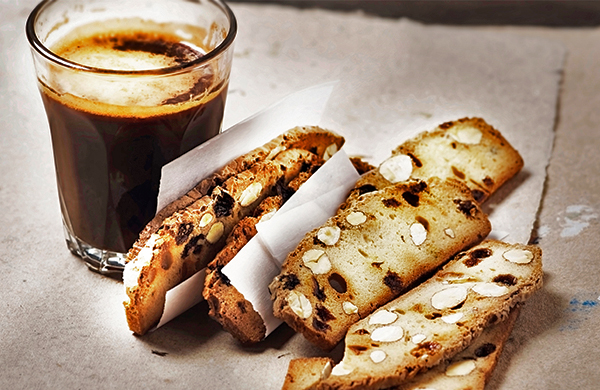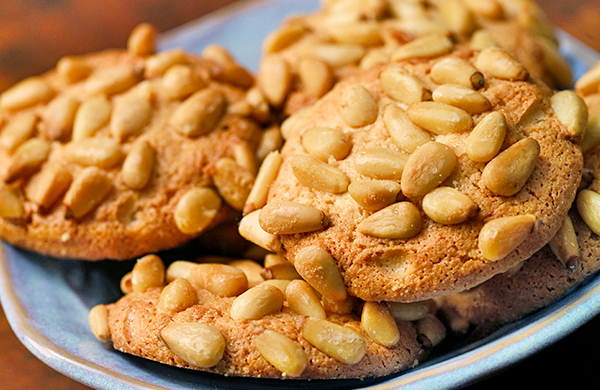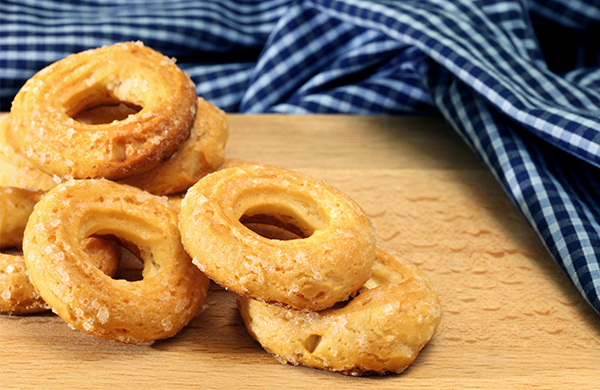
If you typically walk into an Italian bakery and head right for your usual cannoli or slice of tiramisu, you probably aren’t alone. But you might be overlooking the shop’s true showpiece: the cookie case. Any Italian baker worth his or her weight in semolina flour likely has an overwhelming selection of cherry-topped, almond-studded, rainbow-layered cookies available daily, each with a unique name and history behind it.
But it’s exactly this sheer variety that makes the Italian cookie case so intimidating, especially since cookie names like pignoli and cuccidati aren’t as revealing as, say, chocolate chip. So, to encourage you to sample outside your comfort zone, we created this guide to classic Italian cookies (complete with photos!) that will have you ordering with the confidence of a real Italian nonna.
Pignoli Cookies

These pine-nut-studded cookies are actually made with an almond-paste base (a trend that you’ll see repeated throughout this guide), which means they're technically a type of macaron (or amaretti, in Italian). Unlike the almond cookies made in many other cultures, pignoli are chewy, not crispy, and typically enjoyed by Southern Italians on All Saints Day.
Italian Rainbow Cookies

These cookies—which are technically small slices of layer cake—have a cult following and are notoriously hard to find outside New York and New Jersey, where they are most popular. Super-moist almond sponge cake is dyed to resemble the Italian flag, then layered with apricot and raspberry jams and topped with a smear of fudgy, dark chocolate.
Biscotti

Italians use the term biscotti to refer to any type of cookie or cracker, but in America it’s used only to describe this very specific, crunchy companion to cappuccino. Biscotti owe their unique texture—and long shelf life—to a double baking process (the name quite literally means “twice cooked”), as well as the fact that they contain no butter or oil. As such, they are typically made with just flour, sugar, eggs, salt, and almonds, plus any extra flavorings like anise, chocolate, or dried fruit.

Anginetti
The name translates to “light as an angel”, but you’re more likely to know these cookies as “lemon knots”. One of the few types of Italian cookies on this list that don’t feature almonds, anginetti are made with a slightly sweet lemon-butter base, then topped with a citrusy, pucker-inducing icing made from confectioners sugar and lemon extract.
Cuccidati

Think of cuccidati as the Italian answer to fig newtons. Figs are blended with other ingredients, such as raisins, citrus zest, almonds (yes, almonds), cinnamon, clove, and sometimes even brandy, then stuffed inside a tender pastry dough. They are traditionally served during Christmastime, but many bakeries serve them year-round. You might also find these cookies baked into a ring shape, in which case they’re called buccellati (quite literally, “small bracelets”).
Torrone

Technically considered a confection rather than a cookie, torrone resemble biscotti, but they are made of sugar, honey, and egg white, creating a texture that can range from soft and airy to crisp and firm. They are typically loaded with hazelnuts, pistachios, or—surprise!—almonds.
Italian butter cookies

Most Italian bakeries feature all sorts of butter cookies. But the scalloped, circle-shaped ones with the red or green maraschino cherry center always feel the most uniquely Italian of the bunch. Italian butter cookies differ from other types of butter cookies in that they are often made with (you guessed it) almond paste or almond flavoring, but some bakeries prefer a no-nuts approach.
One thing to note: that popular cherry-topped, scalloped design? It’s so popular that some bakeries use it for their coconut macaroons or almond amaretti cookies, too. If you have any doubt about what you’re buying, just ask.
Ciambelle

Italians use the term “ciambelle” to refer to a number of different ring-shaped cakes and breads (including donuts!). But it also refers to a specific type of ring-shaped cookie typically served with wine or coffee. Different regions of Italy have their own way of making ciambelle, and versions range from sweet to savory, so the best way to know what you’re about to eat is to ask your friendly baker’s assistant.